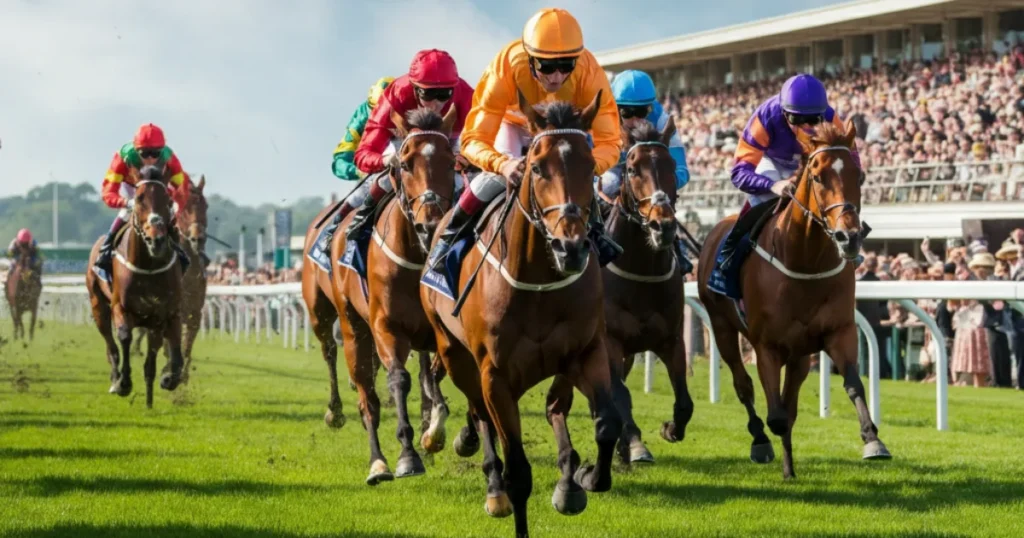Turf Winners, one of the most exciting forms of gambling, involves wagering on horse races that take place on grass surfaces, commonly known as turf tracks. Whether you’re a novice or an experienced bettor, understanding the intricacies of turf racing is essential to increasing your chances of winning. This guide explores everything you need to know to become a successful turf bettor, from key factors influencing turf races to proven strategies for maximizing your profits.
Understanding Turf Winners
Before diving into the betting strategies, it’s important to grasp the fundamentals of turf races and how turf betting works.
What Is Turf Racing?
Turf racing refers to horse races held on grass tracks, which are considered different from dirt tracks. The condition of the turf can change depending on the weather, which in turn influences the race results. Races held on turf tracks are popular worldwide, particularly in countries like the United States, the United Kingdom, and Australia. The unique nature of turf racing makes it an exciting and dynamic field for bettors.
Types of Turf Bets
Turf racing offers a variety of betting options. Understanding these options can significantly improve your strategy and make your betting experience more enjoyable.
- Win Bet: This is the simplest type of bet where you wager on a horse to win the race. The horse must finish first for the bet to be successful.
- Place Bet: A place bet allows you to bet on a horse to finish either first or second. The payout is usually lower than a win bet, but your chances of winning are higher.
- Show Bet: A show bet involves betting on a horse to finish in the top three. It’s less risky than win or place bets but offers a lower payout.
- Exacta: In an exacta bet, you select the first and second-place finishers in the correct order. This bet offers higher payouts due to its complexity.
- Trifecta: This bet involves selecting the first, second, and third-place finishers in the correct order. It’s more challenging to win, but the rewards can be substantial.
- Superfecta: A superfecta bet requires selecting the top four finishers in the exact order. This is one of the most difficult bets to win but offers massive payouts.
Turf Race Distinctions
The key distinction between turf races and dirt races lies in the surface. Turf tracks are soft, and their condition can fluctuate with weather changes. Factors like rain, humidity, and temperature can significantly affect the turf, and this makes it essential for bettors to understand these nuances when placing wagers.
Key Factors Influencing Turf Races
To win consistently in turf betting, it’s important to consider a variety of factors that influence the outcome of a race. These include the condition of the track, the horse’s form, jockey statistics, and trainer performance. Let’s explore these factors in detail.
1. Track Conditions
Turf races are highly influenced by track conditions. The surface can vary from firm (dry and solid) to yielding (soft and wet), and horses perform differently depending on these conditions.
- Firm Turf: When the track is firm, it provides a solid footing for the horses, allowing them to run faster. Horses that have shown excellent performance on firm turf in previous races are more likely to perform well on similar conditions.
- Yielding Turf: Yielding turf is softer and slower, often caused by rain. Horses that are adept at running on softer tracks generally excel under these conditions. Horses that perform poorly on wet tracks should be avoided during these races.
- Heavy Turf: Heavy tracks are often the result of heavy rainfall and can be very soft, making it difficult for horses to maintain their speed. Bet on horses that have demonstrated proficiency on soft or heavy tracks for better chances of success.
It’s crucial to track the weather forecast and check the race-day track conditions to understand which horses might have an advantage.
2. Horse Form and Performance History
One of the most significant factors influencing race outcomes is the horse’s past performance, or form. Here’s what you need to consider:
- Recent Form: Horses that have been performing well in recent races are more likely to perform well again. Look for horses that have consistently finished in the top positions over the past few months.
- Race Distance: Some horses excel at certain race distances. Consider whether the race distance fits the horse’s preferred distance. Some horses are sprinters, excelling in shorter races, while others perform better in longer distances.
- Track Experience: A horse’s previous success at a particular turf track can be a good indicator of future performance. Horses familiar with a specific track may have an edge due to their knowledge of the course and its nuances.
3. Jockey and Trainer Influence
The jockey and trainer play pivotal roles in determining a horse’s performance. Their experience and track record should not be overlooked when placing bets.
- Jockey Experience: Experienced jockeys often know how to handle the nuances of turf racing. The ability to read the race, position the horse strategically, and respond to conditions is critical.
- Trainer Statistics: Trainers with a good track record, particularly at turf races, are valuable resources for ensuring a horse is well-prepared. Trainers often have a good sense of which horses perform well on turf and under specific conditions.
When analyzing jockeys and trainers, look for those who have a proven track record in turf racing, as this can increase your chances of winning.
4. Post Position
Post position refers to the starting stall from which each horse starts the race. Horses with inside positions (closer to the rail) are typically more advantageous in shorter races, as they have a quicker route to the first turn. On the other hand, outside positions can sometimes be more beneficial in longer races as they allow the horse more space to maneuver.
Keep in mind that post position plays a more prominent role in shorter turf races, where positioning at the start is critical. For longer races, the quality of the horse and its stamina become more important.
Turf Betting Strategies for Consistent Wins
Now that we’ve covered the key factors influencing turf races, let’s move on to the strategies that can increase your chances of winning.
1. Research and Analysis
Research is the cornerstone of any successful betting strategy. Make sure you analyze the following:
- Horse Performance: Always review the past performance records of the horses. Pay attention to their performance on turf tracks, particularly under similar weather conditions.
- Jockey and Trainer Statistics: Study the success rates of the jockeys and trainers involved. A strong partnership between jockey and trainer often leads to better performance.
- Track Conditions: Make sure to check the race-day track conditions. Turf performance can drastically change depending on whether the track is firm, yielding, or heavy.
By taking the time to thoroughly analyze these factors, you can identify the horses that are most likely to win.
2. Focus on Value Betting
One of the most effective strategies for long-term success in turf betting is value betting. This involves identifying bets where the odds offered by the bookmaker are higher than the true probability of an event occurring. This requires experience and skill in assessing horses and races.
Look for horses that have a higher chance of winning than the odds suggest. By focusing on value bets, you can improve your chances of turning a profit over time.
3. Diversify Your Betting Portfolio
While win bets are straightforward, adding variety to your betting strategy can enhance your chances of winning big. Consider incorporating exotic bets like exactas, trifectas, and superfectas into your strategy. These bets are riskier but offer higher rewards.
Balance your bets by placing small wagers on exotic bets and larger wagers on win or place bets, depending on your confidence level.
4. Manage Your Bankroll
Effective bankroll management is crucial for successful betting. Never wager more than you can afford to lose, and set a budget for each betting session. Consider following a staking plan, where you bet a fixed percentage of your bankroll depending on your confidence in a particular race or horse.
This disciplined approach helps prevent excessive losses and ensures you have enough funds to keep betting and learning from your experiences.
5. Monitor Market Movements
Track the betting odds throughout the day to see how they change as the race approaches. Significant shifts in odds can indicate insider information or reveal where the majority of the betting public is placing their money. Monitoring these shifts can give you an advantage, as you may spot opportunities for value betting.
6. Leverage Technology
In today’s digital age, there are numerous tools and apps that can help improve your betting strategy. You can use:
- Betting Exchanges: These platforms allow you to place bets directly against other bettors, often offering better odds.
- Race Analysis Tools: Many online platforms provide tools to analyze horse performance, track conditions, and other relevant data.
- Mobile Apps: Betting apps provide convenience, enabling you to place bets and monitor races on the go.
These tools can give you an edge in making more informed decisions.
Conclusion
Turf betting offers both excitement and opportunity, but it requires skill, research, and discipline. By understanding the factors that influence turf races and implementing proven betting strategies, you can increase your chances of success. Whether you’re placing win bets or exotic bets, always stay informed, manage your bankroll wisely, and focus on value betting to maximize your returns.
Remember, becoming a consistent turf winner takes time, but with the right approach and dedication, you can make the most of your turf betting experience. Keep learning, stay patient, and enjoy the thrill of the races!







